Your sales team spent 40 hours last month pitching to prospects who never had budget approval.
HubSpot reports that 61% of marketers now prioritize qualified leads over sheer volume, yet most teams still lack a systematic way to separate real opportunities from time-wasters. The result? Reps chase leads that were never going to close while high-value prospects slip through the cracks.
A lead qualification checklist fixes this. It gives your team a repeatable framework to identify who deserves attention, when to disqualify early, and how to prioritize deals that actually convert.
This guide delivers the complete checklist, proven frameworks, and automation strategies you need to qualify leads faster and more accurately.
What is lead qualification and why it matters for sales success
Definition of lead qualification
Lead qualification determines whether a potential customer deserves your sales team’s time and resources. Instead of treating every ebook download or contact form submission as a hot prospect, you assess if a lead matches your ideal customer profile and truly needs your solution.
You focus on key information such as:
- Budget: identifying if they can afford your solution
- Authority: confirming decision-making power
- Need: verifying they have the specific problem you solve
- Timeline: checking if they are ready to act soon
Effective qualification shifts your outreach from scattershot to focused. Without this, reps waste hours on leads lacking budget, authority, or relevant pain points.
The business impact of qualifying leads properly
HubSpot reports that 61% of marketers now prioritize qualified leads over sheer lead volume.
A mature qualification process delivers:
- 9.3% higher sales quota attainment (CSO Insights)
- 26% higher conversion rates, 50% more revenue, and 25% lower cost per lead (Aberdeen Group, 2024)
These results shorten sales cycles, boost marketing efficiency, and provide sales and customer success teams with better-fit prospects. This reduces churn and increases lifetime value.
Common mistakes when qualifying leads without a checklist
Unstructured qualification leads to inconsistency and poor forecasting. Frequent mistakes include:
- Unsystematic conversations where reps ask different questions, making deal outcomes unpredictable
- Confusing interest with qualification, as enthusiasm or demo requests mean little if prospects lack budget or authority
- Failing to disqualify early, keeping poor-fit leads in the funnel and wasting time
- Avoiding hard questions about budget and authority, delaying answers and costing weeks of effort
- Using subjective standards, relying on individual judgment which prevents measurement and optimization
By standardizing your criteria and using a checklist, you make qualification objective, measurable, and repeatable.
Understanding the different types of qualified leads
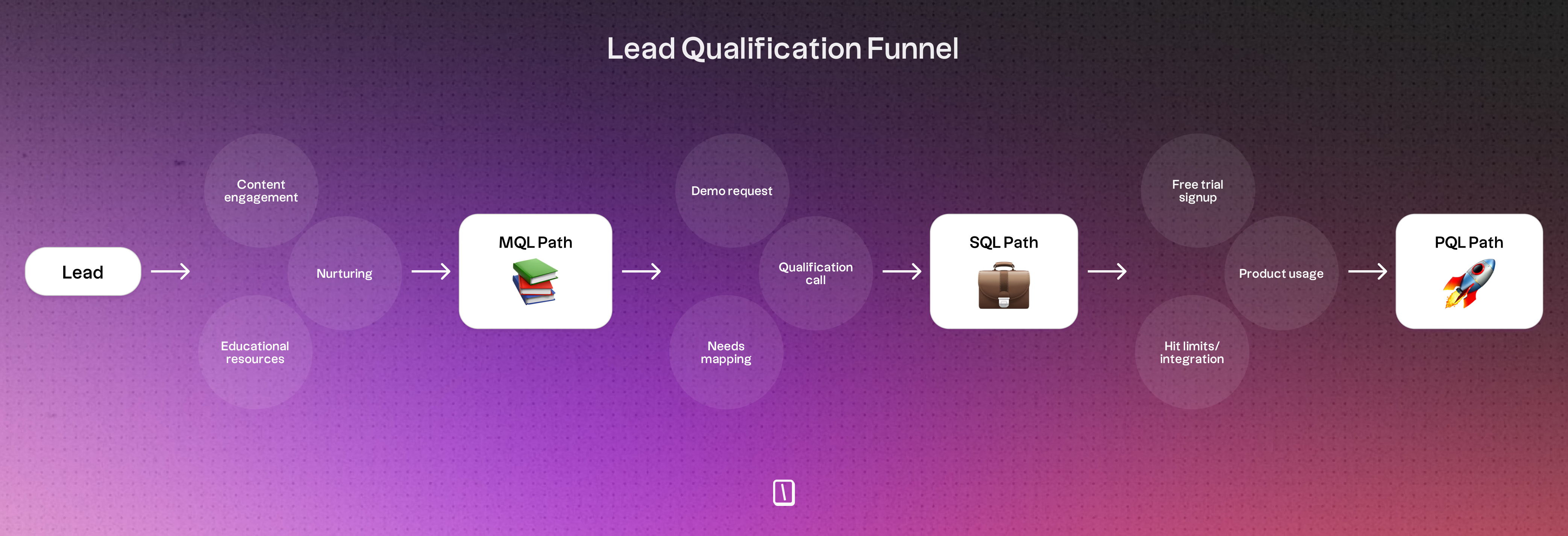
Not all leads are equal. Different qualification stages show readiness and require specific actions.
Marketing qualified leads (MQL)
These leads show sustained interest by downloading whitepapers, attending webinars, or engaging with various content. They are exploring whether your solution might fit their needs but are not yet showing clear buying intent.
Handle MQLs by nurturing them with targeted content, email sequences, and educational resources. Move them to sales once they start actively evaluating, such as requesting a demo, asking for pricing, or raising implementation questions.
Sales qualified leads (SQL)
Sales qualifies these leads after confirming a real problem, decision-making authority or influence, and a realistic timeline. They provide details on current workflow issues, affected teams, and timing for a solution.
Focus on qualification conversations and mapping your solution to their specific needs. Prioritize next steps that advance the deal, including scoping, proposals, and aligning stakeholders.
Product qualified leads (PQL)
These users have tried the product and shown its value through specific in-product behaviors. Examples include signing up for a free plan, reaching usage limits, building essential assets, or integrating with other systems.
Shift the conversation from proving value to removing barriers for expansion, such as discussing pricing tiers, enterprise features, and budget approval. Set clear behavioral triggers to identify true buying intent, so you don’t treat every trial user as a PQL.
Adapt your process to each lead type: educate MQLs, qualify and map solutions for SQLs, and enable PQLs for expansion and implementation.
The essential lead qualification frameworks you need to know
Frameworks help structure sales conversations and ensure you ask the right questions consistently. No single model suits every business. Use these frameworks as starting points and adapt them to your market, deal size, and sales process.
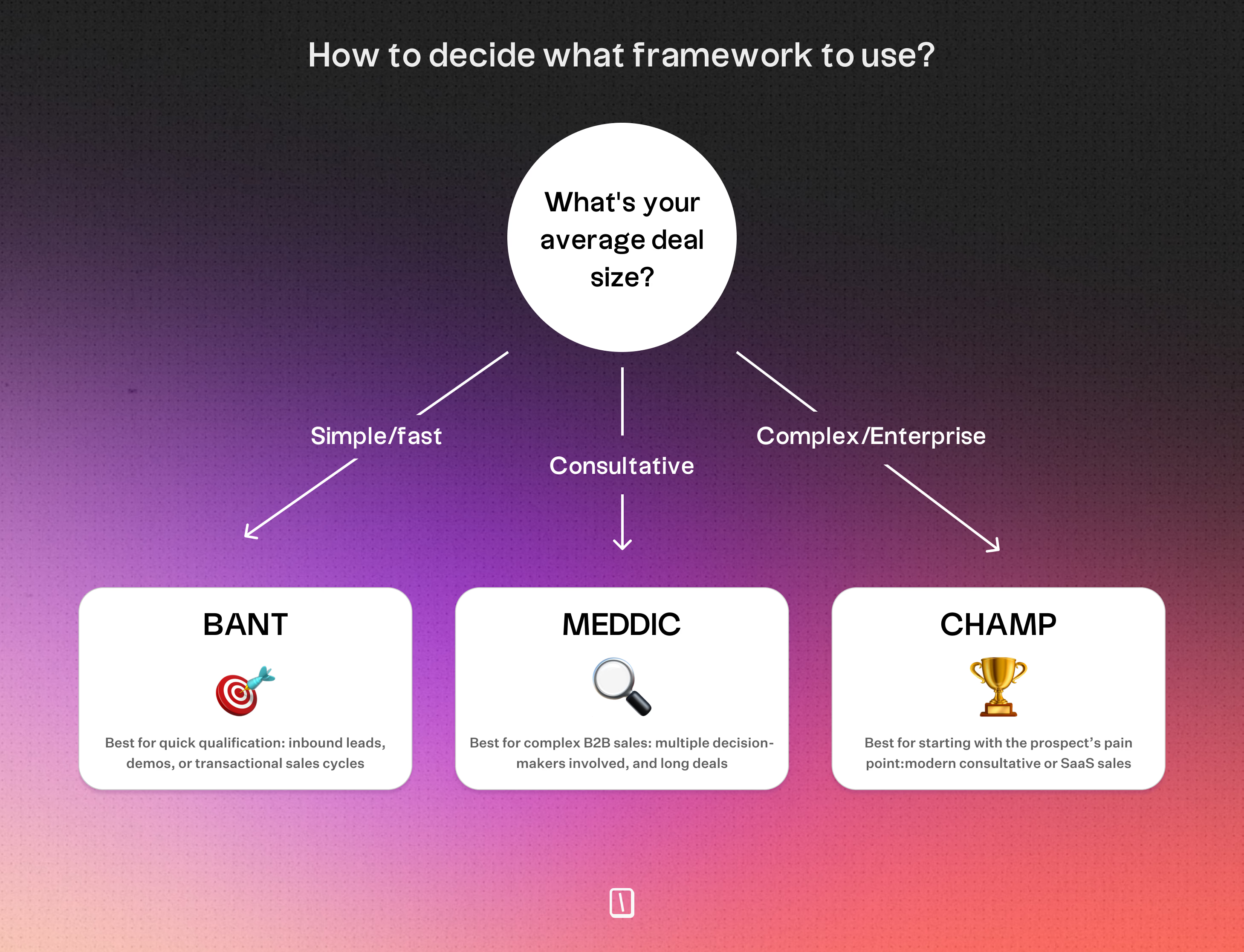
BANT framework (budget, authority, need, timing)
Developed at IBM in the 1950s, this framework is simple, direct, and focuses on deal-breakers.
Check these elements:
- Budget — Confirm allocated funds, not just promises based on potential ROI. Avoid leads that truly cannot pay.
- Authority — Identify the person who can sign and those who influence decisions. An expression of interest is not the same as decision-making power.
- Need — Verify a real, measurable problem your solution can address. Interest alone does not create urgency.
- Timing — Determine when they intend to decide. Vague answers like "sometime this year" often indicate low priority.
Use BANT for straightforward B2B deals with clear procurement cycles. When multiple stakeholders or complex buying processes exist, BANT might overlook important details.
Explore our guide on B2B lead qualification to discover additional frameworks and best practices.
CHAMP framework (challenges, authority, money, prioritization)
CHAMP focuses on the problem before price.
Core elements include:
- Challenges — Begin with the pain points driving the buying process. This centers the conversation on value.
- Authority — Know the decision-makers to help navigate internal politics.
- Money — Discuss budget after establishing concrete value, shifting from price to the cost of inaction.
- Prioritization — Understand where the initiative ranks among competing projects to set realistic timelines.
This framework suits consultative sales where problem-solving and relationships matter. It is less effective for purely transactional buyers.
MEDDIC framework (metrics, economic buyer, decision criteria, decision process, identify pain, champion)
Designed for complex enterprise deals, MEDDIC requires more upfront detail to reduce surprises later.
Its components are:
- Metrics — Quantify impact by linking improvements to measurable business outcomes.
- Economic buyer — Identify who controls the budget and their priorities; the daily contact may not be the final decision-maker.
- Decision criteria — Understand how buyers evaluate vendors to align your offering accordingly.
- Decision process — Map approvals, procurement steps, security reviews, and proofs of concept.
- Identify pain — Investigate tactical issues causing urgency and the costs involved.
- Champion — Find an internal advocate who promotes your solution and helps overcome obstacles.
Use MEDDIC for high-value, long-cycle enterprise opportunities. It is too detailed for low-cost or quick SMB deals.
ANUM, FAINT, and GPCTBA/C&I frameworks compared
These frameworks offer quick qualification options with different focuses:
- ANUM (Authority, Need, Urgency, Money) — Places Authority first to quickly filter gatekeepers. Efficient but may seem dismissive if you dismiss lower-level contacts quickly.
- FAINT (Funds, Authority, Interest, Need, Timing) — Recognizes buyers might access discretionary funds and treats Interest as a distinct success predictor.
- GPCTBA/C&I (Goals, Plans, Challenges, Timeline, Budget, Authority, Consequences & Implications) — Combines tactical and emotional factors. Consequences and Implications clarify the cost of inaction for prospects.
Choosing and combining frameworks
Match the framework to your sales process:
- A quick two-call SMB deal usually does not need MEDDIC.
- An 18-month enterprise pursuit often cannot rely on BANT alone.
Many teams blend methods: for example, using budget checks from BANT, challenge-first framing from CHAMP, and champion identification from MEDDIC to fit their approach.
Remember, frameworks serve as guardrails, not scripts. Use them to avoid missed questions, keep consistency, and make qualification measurable and repeatable.
The ultimate lead qualification checklist with ready-to-use questions
A concise checklist helps reps move quickly from curiosity to clarity. Knowing when to advance a conversation or pull back saves time and improves win rates.
Use the sections and questions below as a practical script to weave into natural conversation.
Interest and engagement level

Look for behaviors and answers that show active evaluation, not casual browsing.
Ask questions like:
- "What prompted you to reach out today?" to reveal triggers and urgency.
- "How familiar are you with [this type of solution]?" to gauge research and category knowledge.
- "What have you tried so far to address this?" to understand commitment and sophistication.
- "Who else on your team is involved in this research?" to see if this is a solo exploration or team effort.
Vague responses often indicate early-stage interest. Specifics about comparisons, internal discussions, or past tests show real engagement.
Pain points and needs assessment
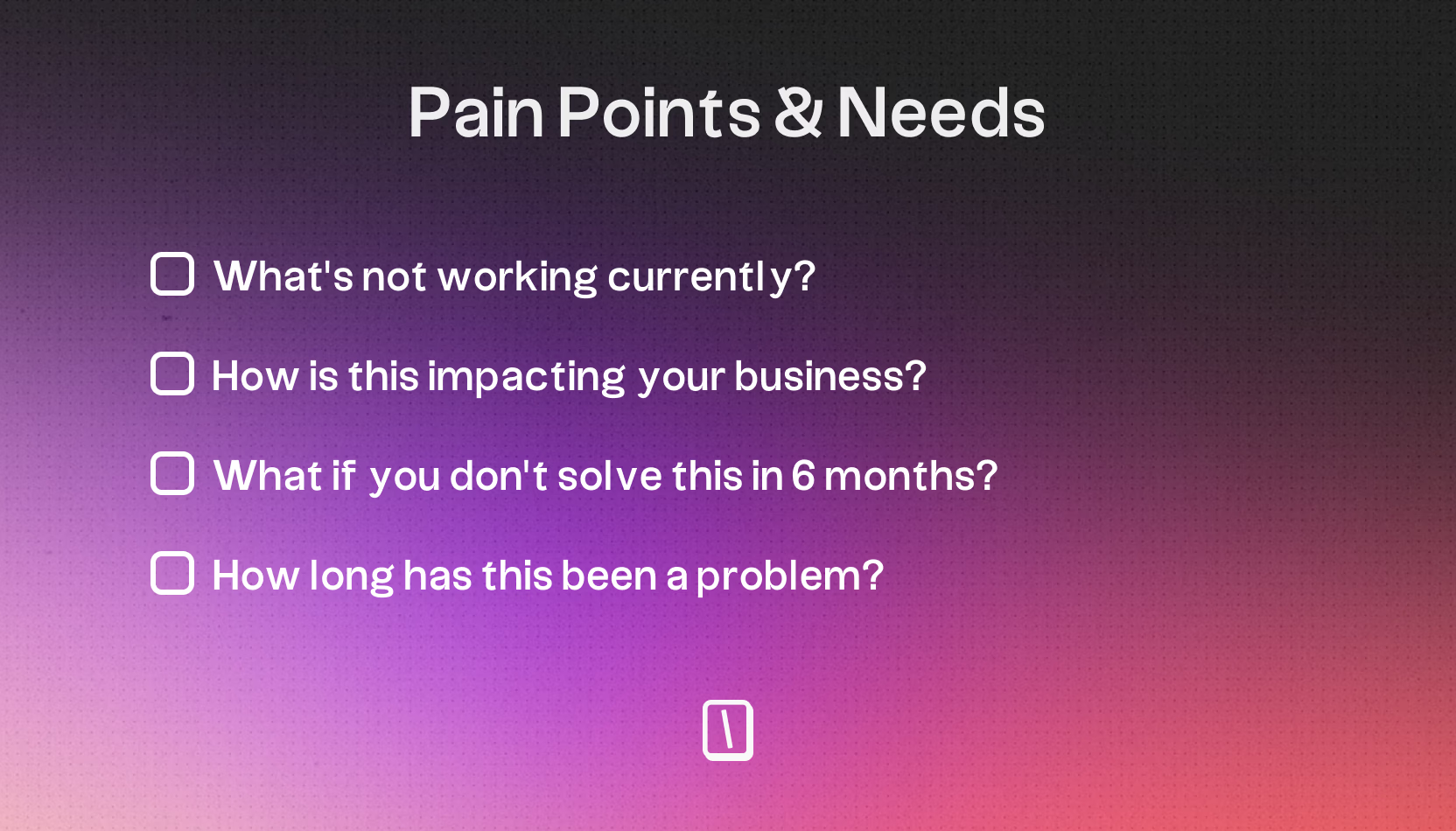
Focus on the intensity, frequency, and concrete cost of the problem.
Ask questions such as:
- "What's not working with your current approach?" to let them describe the issue themselves.
- "How is this impacting your business right now?" to identify revenue, customer, or operational effects.
- "What happens if you don't solve this in the next six months?" to surface urgency.
- "How long has this been a problem?" to measure persistence and failed alternatives.
- "On a scale of 1–10, how critical is solving this to your success this year?" since a score below 7 suggests lower priority.
The best answers explain why the pain has reached a breaking point now, not just that a problem exists.
Budget and financial capacity
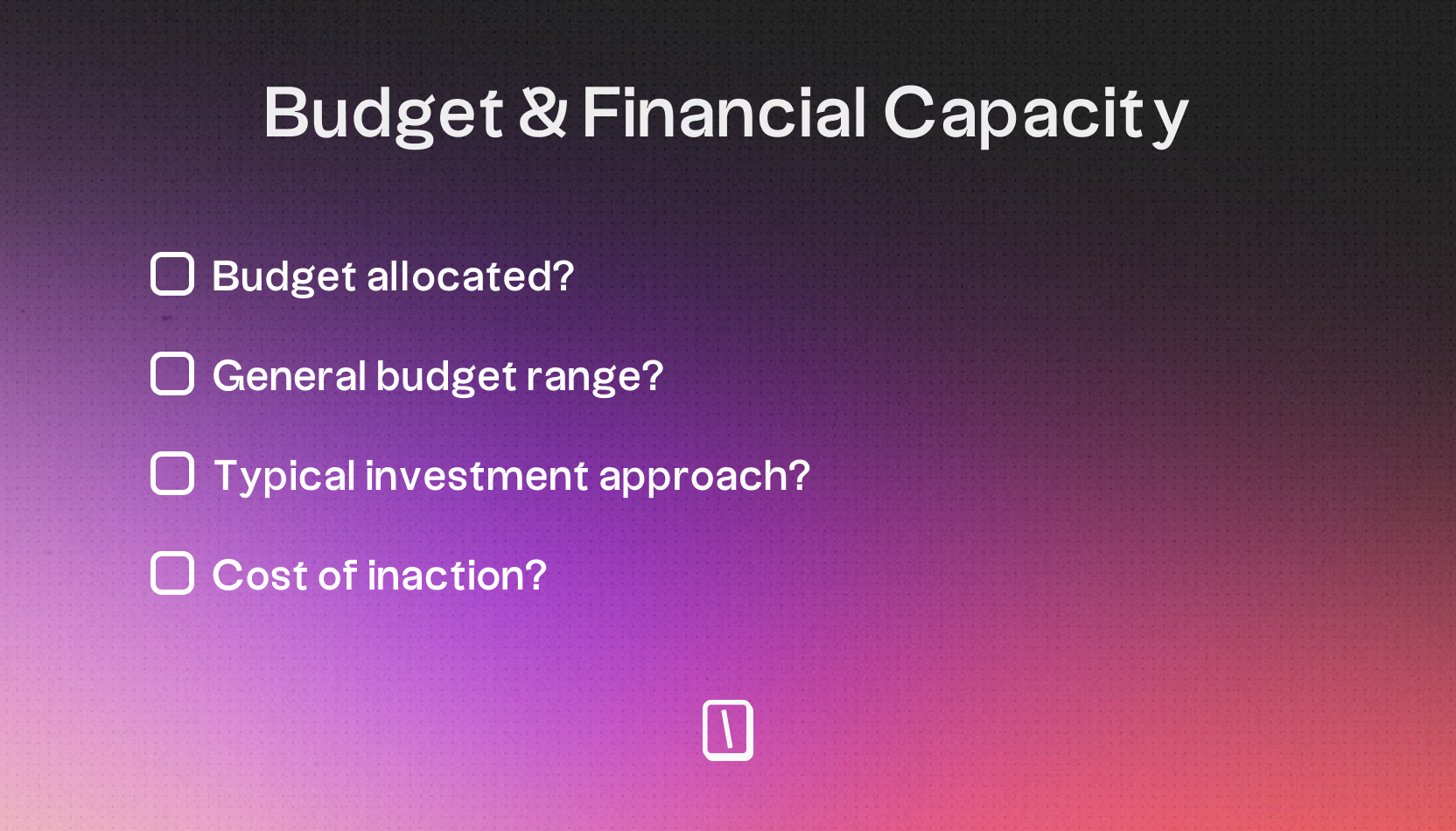
Address money early to avoid wasted effort, but frame it as practical alignment, not interrogation.
Ask these questions:
- "Have you allocated budget for this type of solution?" to distinguish funded projects from aspirational ones.
- "What's your general budget range for solving this problem?" to prevent major mismatches.
- "How does your company typically approach investments like this?" to uncover procurement and approval patterns.
- "What's the cost of not solving this problem?" to help convert impact into investment rationale.
- "Are there competing budget priorities we should be aware of?" to identify obstacles.
Hesitation or vagueness around budget often signals lack of authority or early-stage research.
Authority and decision-making power

Map who decides, who influences, and who can block the deal.
Ask questions like:
- "Walk me through how decisions like this typically get made at your company." to reveal committees, approval chains, and gatekeepers.
- "Who else needs to be involved in this decision?" to clarify stakeholders.
- "Have you made similar purchases before? What was that process like?" to understand likely timelines and blockers.
- "What happens after our conversation—what are the next steps on your end?" to indicate agency.
- "Is there anyone who might object to this type of investment?" to surface potential skeptics.
Authority is rarely binary; identify who can approve, veto, and champion the idea. If your contact can’t connect you to other stakeholders, treat that as important information, possibly a red flag.
Timing and urgency evaluation

Confirm whether the opportunity requires immediate action or long-term nurturing.
Ask questions such as:
- "What's driving the timeline for this decision?" to find deadlines like renewals, launches, or compliance.
- "When do you need this solution implemented and working?" to check onboarding fit with your delivery timeline.
- "What happens if this isn't in place by [their timeline]?" to verify consequences.
- "Are you actively evaluating other solutions right now?" to signal buying stage.
- "What could prevent or delay this decision?" to identify risks like budget freezes or organizational changes.
Concrete dates and forcing functions indicate higher priority than vague future plans. Someone claiming urgency but unable to book a follow-up likely signals lower priority.
Qualification works best as a collaborative problem-solving conversation, not interrogation. Use these questions adaptively, follow up on specifics, and prioritize next steps based on what you learn.
Qualification conversations work best when you ask the right questions at the right time. Explore our lead qualification questions guide to discover the most effective prompts for uncovering timing, budget, and decision-making authority.
Step-by-step process to implement your lead qualification checklist
1. Define your ideal customer profile (ICP)
Be specific about who benefits most from your product and remains loyal.
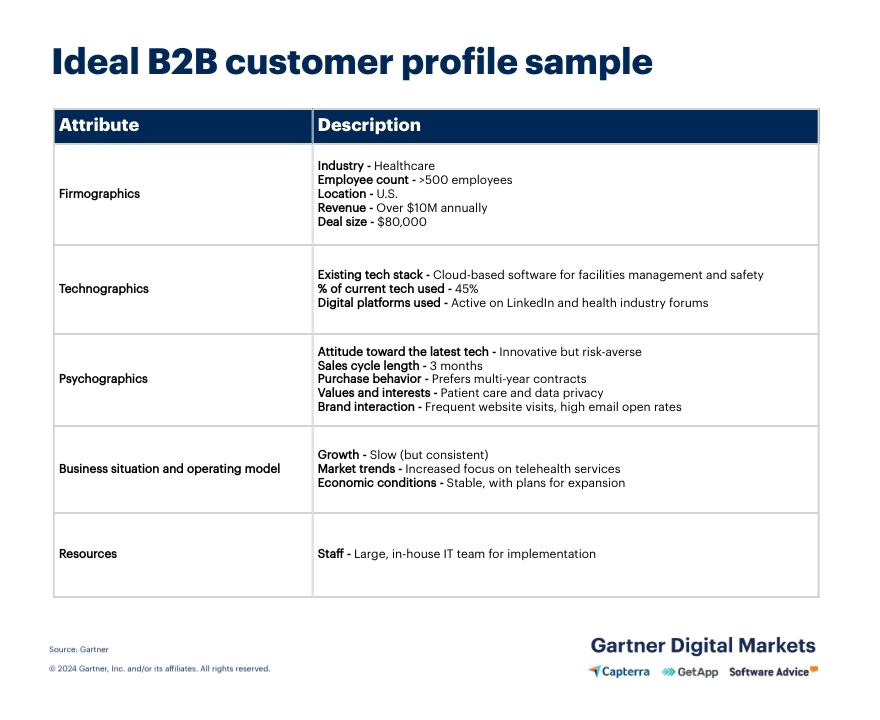
Start by reviewing your best customers. Look for those with:
- Highest lifetime value
- Fastest time-to-value
- Strongest retention
Capture key details:
- Firmographics such as company size and industry
- Tech stack, team structure, budget range, and growth stage
- Behavioral and motivational traits like pain points, buying triggers, and procurement steps
Use the ICP to prioritize leads, shape qualification questions, and decide when to pass a lead to sales or decline it.
Document the ICP in a shared location so marketing, sales, and success teams use the same definition.
2. Set up lead scoring criteria and thresholds
Translate the ICP into a repeatable scoring model combining fit and intent.
Assign scores based on:
- Fit criteria: company size, industry, role, and other ICP attributes
- Behavioral signals: demo requests, pricing page visits, content downloads, and repeat site visits
Combine fit and behavior into a single score. Set thresholds such as:
- Above 70: pass to sales
- Between 40 and 70: nurture
- Below 40: stay with marketing
Calibrate thresholds using historical data and revisit them regularly as your ICP or go-to-market approach changes.
Clear thresholds prevent premature handoffs and keep under-qualified leads out of reps’ calendars.
3. Prepare discovery call questions and scripts
Equip reps with conversation flows that reveal qualification details naturally.
Start with broad, open-ended prompts about the problem and recent triggers. Follow with targeted questions about:
- Budget
- Decision-makers
- Timeline
- Success metrics
Provide phrasing options for phone, video, email, and chat to cover the same criteria naturally.
Train reps in listening techniques and how to pivot when new information arises.
Scripts should guide conversations, not replace them.
4. Establish qualification and disqualification rules
Make hard choices explicit so reps confidently focus on the right prospects.
Define:
- Automatic qualifiers — must-have attributes
- Hard disqualifiers — non-negotiables like industry exclusions or minimum budget
Document edge cases with escalation paths for exceptions.
Give reps a standard response for disqualification along with clear next steps, such as:
- Nurture track
- Partner referral
Reinforce that disqualification is a strategic action, freeing time for higher-probability opportunities.
Consistency here reduces debate and improves forecast accuracy.
5. Create a process for recycling unqualified leads
Unqualified today does not mean unqualified forever. Build paths to keep potential buyers engaged.
Route disqualified leads into segmented nurture sequences based on their disqualification reason, such as timing, budget, or authority.
Set automatic re-evaluation triggers based on time or behavior to rescore and reassign leads.
Track conversion rates from recycled leads and analyze what changes when these leads later qualify.
Use these insights to refine your ICP, scoring, and nurture content.
A defined recycling process preserves long-term opportunities without draining sales bandwidth.
Implementing a checklist requires discipline more than complexity. Define who you want to talk to, score consistently, script naturally, enforce rules, and recycle smartly. Following these steps turns qualification from guesswork into a measurable advantage.
Automating lead qualification to scale your sales process
Automation handles repetitive screening, letting your sales team focus on high-value conversations. It enhances human judgment without replacing it.
Setting up automated qualification flows in your CRM
Translate your checklist into CRM workflows by turning each criterion into a data field and each threshold into a trigger.
Start with simple steps, such as:
- Defining fields and triggers for company size, budget, role, and behavior.
- Passing leads that meet minimum fit directly to a discovery invite.
- Routing others to nurturing sequences.
- Adding conditional branches to separate buyer types, like enterprise versus SMB, and behaviors like pricing page visits versus newsletter signups.
- Using visual workflow builders to view and improve the lead journey.
Begin with one or two automated checks. Expand as you identify rules that deliver real results.
Using chatbots for initial qualification screening
Chatbots can conduct the first short conversation, gather structured answers, and route leads correctly.
Automate by:
- Asking core qualifiers such as the problem, timeline, team size, and decision authority.
- Routing based on answers to book meetings, send to support, or enroll in nurturing.
- Offering self-service resources when budget or timeline is not a match through conditional branching.
Design bots to keep conversations brief and context-aware. Collect exact fields your CRM needs to score and route leads. Ensure the bot transfers leads to humans for high intent or complex responses.
See it in action: Try this simple screening bot that qualifies leads in under 90 seconds:
This example demonstrates how a conversational approach collects the same qualification data as a traditional form, but feels more engaging and achieves higher completion rates. Notice how the bot routes differently based on company size, timeline, and expressed need—exactly the kind of intelligent branching that scales your qualification process.
Want to explore more advanced chatbot capabilities beyond lead qualification? Check out the best chatbot builders to see how different platforms handle automation, routing, and personalization at scale.
Implementing lead scoring automation
Automated scoring ranks leads by combining fit and intent into a dynamic score.
Set this up by:
- Assigning points to signals like case study downloads (+10), company size over 50 (+15), and pricing page visits (+20).
- Updating scores in real time as behaviors accumulate.
- Calibrating weights according to your business model, whether it's product usage for SaaS or firmographics for consultants.
- Applying decay rules so inactive leads gradually lose points.
Use score thresholds to trigger next steps: instant follow-up for high scores, nurture campaigns for mid-level scores, and monitoring for low scores.
Triggering automated follow-ups based on qualification status
Let qualification status control personalized outreach and lifecycle actions.
Examples include:
- Notifying the assigned rep and launching a tailored sequence referencing pain points when a lead reaches the SQL threshold.
- Starting longer nurture paths with relevant content and periodic rescoring for mid-score leads.
- Routing disqualified leads to self-service resources or targeted education and scheduling re-evaluations.
Maintain human override capability to handle exceptions and nuances. Automation should cover routine tasks, allowing reps to focus on complex deals and special cases.
How Typebot helps automate lead qualification with conversational chatbots
Traditional forms overwhelm prospects with long fields and one-way questions. Typebot replaces this with a conversational flow that adapts to responses. It guides people through qualification without feeling like filling out a form.
The visual builder lets you design intentionally: map the decision tree, control branching, and reuse logic without coding. For example, if a visitor needs a solution within a month, the bot asks about budget and decision-makers. If they are just researching, it shifts to education and lighter data collection.
Building a qualification bot with visual flows and conditional logic
Start by sketching possible conversation paths. The drag-and-drop editor displays the entire flow, helping you spot gaps or unnecessary steps that cause drop-off.
These tools enable natural, non-linear conversations that still collect structured data.
Collecting key qualification data through smart questions
Use input types that provide reliable, scoreable answers while preserving nuance in open text.
Arrange questions from less to more sensitive. Prospects respond better when they feel understood before sharing commitments.
Integrating with your CRM and lead scoring tools
Data collected by Typebot flows into your systems for quick action. It sends variables through webhooks or direct integrations to create or update lead records instantly.
Integration options include:
- Webhook block for custom endpoints and API connections to scoring engines
- Native integrations with Google Sheets for simple CRMs
- Zapier and Make for multi-step automations like CRM updates, email sequences, Slack alerts, and task creation
- Hidden fields to pass campaign metadata (e.g., UTM parameters) into conversations, enabling source-aware branching
All variables are sent as JSON, so downstream systems can apply scoring, assign reps, or tag leads based on your rules.
Measuring qualification performance with built-in analytics
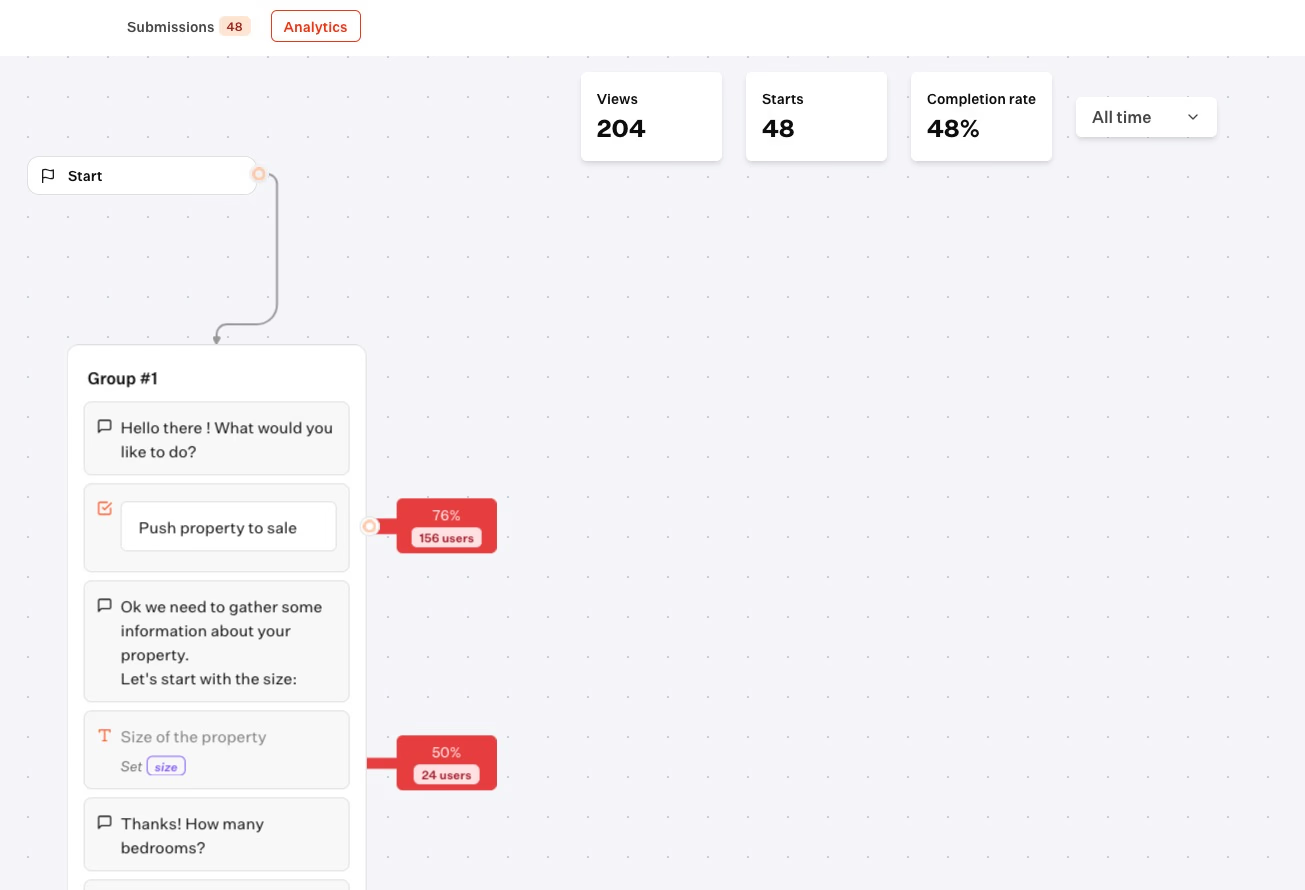
Analytics show where conversations convert or fail. Use flow metrics to improve your bot quickly.
Track drop-off rates, completion rates, and traffic source quality to identify friction points and flow issues. Analyze AB test results and open-text responses for insight into question ordering and positioning opportunities. Export conversation data to CSV to identify which attribute combinations predict conversion, then refine your scoring and ideal customer profile accordingly.

Create fully customizable chatbots without writing a single line of code.
No trial. Generous free plan.
Measuring and optimizing your lead qualification process
Track numbers that show if your checklist works well. Focus on these key metrics:
- Qualification rate: the percentage of leads passing initial screening. If it is too high (over 80%), your criteria may be too weak. If it is too low (under 20%), you might be filtering out potential buyers.
- Time to qualify: the time from lead entry to qualified or disqualified status. Aim to qualify leads within 24 hours. Taking more than three days signals process delays.
- Conversion rates by stage: monitor the transition from MQL to SQL to Opportunity and compare across channels. A healthy benchmark is around 25% or more for MQL to SQL. If it falls to 10%, review your criteria or follow-up process.
- Average deal size from qualified leads: it should be higher than deals from unqualified leads. Otherwise, you are capturing engagement but not true buying intent.
- Cost per qualified lead versus cost per raw lead: use this to validate your qualification process investment and optimize spending.
Set up your CRM with timestamps and dashboards that display these metrics. Analyze them by source, campaign, and sales rep to identify patterns.
Turn your lead qualification checklist into revenue
Lead qualification transforms from guesswork into a predictable system when you follow a structured checklist.
Start with the frameworks that match your sales motion. Build qualification questions around budget, authority, need, and timing. Then automate screening with tools like Typebot to capture qualification data through conversational flows that feel natural, not interrogative.

Use Typebot's conversational forms to simplify data collection and boost engagement.
No trial. Generous free plan.